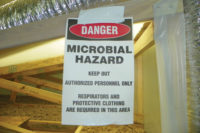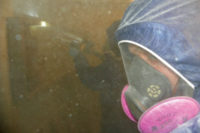Asbestos: Still a Stumbling Block in Restoration and Remediation
The sobering reality is asbestos was and is used in building materials to this day










I once was fearful of sounding like a broken record. But, nearly 20 years of industrial hygiene consulting and teaching environmental health and safety suggest the hazards, regulations and ubiquity of materials containing asbestos fibers beseech repeating.
Ashes to Ashes, Asbestos Dust to Dust
Death is an unpleasant inevitability. It is the ticket price every human pays for the privilege of riding the rollercoaster of life. This ride ends for approximately 2.5 million Americans each year. There is a seemingly endless list of causes of death. Heart disease kills about 600,000 of us annually. Around 123,000 meet their demise from accidents. Flu and pneumonia ends fun for nearly 54,000 Americans.
With these statistics fresh on your mind, you will probably be surprised to read around 10,000 U.S. citizens die each year from asbestos-related diseases. You might even be inclined to think something like “That’s all?” or “10,000 is not too bad.” In light of the 2.5 million deaths per year, you might be further underwhelmed by the breakdown of annual U.S. asbestos-related deaths, which include 1,398 from asbestosis, 2,509 from mesothelioma, 4,800 from related lung cancer and 1,200 from related gastrointestinal cancer.
So, why even worry about asbestos? I submit, in no particular order, three pretty strong reasons you should be concerned about asbestos. First, most of these 10,000 deaths are preventable. Second, federal laws (and many state, county and city laws) clearly state you shall consider asbestos. And third, someone you love might be one of the 10,000.
Surprise, Surprise, Surprise
Before we get into detail, let’s see if you can answer one simple question. What year was asbestos banned for use in the United States? Take your time. (Insert the “Jeopardy” theme music here.) Do I hear 1970…1980…1930… 1990? All common guesses, but the answer is “never.”
Yes, I said never.
This comes as a huge surprise to the vast majority of the people I encounter around the country in classes and on projects. This simple statement “never” does have some nuances. You can find a lot more on this at www.epa.gov/asbestos/federalbans.html if you really want to “geek out,” as the young people say. But, for your clients and for your team members, it is important that you hear, echo and remember the word “never.”
As I mentioned, if you missed the question you are not alone. Many presume asbestos is a problem of the past. The sobering reality is asbestos was and is used in building materials to this day. It is estimated approximately 2,500 metric tons of asbestos are being imported into the U.S. every year. This is a dramatic reduction from the 1974 peak production of around 750,000 metric tons. But over 30 million tons of asbestos have been mined and used in production since early last century. And, since asbestos doesn’t evaporate or degrade into less harmful materials, it is important to consider installed or stored products containing asbestos fibers remain a potential hazard ad infinitum.
It is true that asbestos litigation, proposed bans and news coverage were prevalent in the 1970s and 1980s. As a result many U.S. manufacturers voluntarily removed asbestos from their wares to reduce their product liability. The key word “many” does not mean “all.” Further, as a nation we continue to import more and more of our building materials from countries with less stringent environmental regulations and/or controls (China, Mexico, India, etc.). Regularly, I receive e-mails from Chinese firms requesting I purchase their “dust free” asbestos rope, asbestos gaskets, asbestos resilient flooring, asbestos roof tiles, etc.
So, What is Asbestos Really?
Asbestos is a general term referring to six different regulated fibrous, silicate minerals, including:
- Chrysotile (White asbestos, the most common)
- Amosite (Brown asbestos, also known as cummingtonite-grunerite, the second most common)
- Crocidolite (Blue asbestos, also known as riebeckite)
- Actinolite
- Anthophyllite
- Tremolite
These six asbestiform minerals are segregated into two categories, serpentine (which includes chrysotile) and amphiboles (which includes all the others). Amphiboles are considered by some to be the category of higher risk due to certain properties.
Eeny, Meeny, Miny, Moe
Exactly what kinds of materials contain asbestos? Asbestos is present in a surprisingly wide variety of products such as hair dryers, ceiling tile, brake pads and over 3,000 other products you may use every day. We could list virtually every building material from roofing, to stucco, to drywall, to fireproofing, to plaster, to vinyl sheeting, to vinyl floor tile, to lay-in ceiling panels, to pipe insulation, to paint, to… But, the list is far shorter when you ask, which building materials do not contain asbestos? Building materials are suspected to contain asbestos fibers unless they are uncoated glass, metal or wood. Consider them as such and avoid hazards, litigation, bad press and citations.
But, I Read The MSDS…
People frequently err by thinking material safety data sheets, or MSDS, are required to list all hazardous materials. This is a topic for another day, but in brief, they are not. No one wants to draw attention to the “A” word in their product. Often the presence of asbestos is simply not listed. Sometimes the presence of asbestos actually is listed on the MSDS or right on the product label, but the listing may be incognito. Keep a sharp eye out for sneaky phrases like “contains mineral fibers,” “contains chrysotile” or “contains amphiboles.” Just remember that a label without asbestos does not mean the product is asbestos free.
Why Was/Is Asbestos So Popular?
Asbestos is quite abundant on the Earth. It is present in approximately two-thirds of the planet’s rocks. Appealingly, it is cheap to bring to market. You simply dig it up, crush it and add it to your product. No bleaching, heating or synthesizing is needed. Asbestos has several desirable properties that read like Superman’s resume including resistant to high heat, resilient against corrosion and impervious to organic degradation. It has a high tensile strength (stronger than steel) making it a good binder. It is an excellent thermal, acoustic and electrical insulator. Finally, it is the only mineral that can be woven into fabric. Up, up and away!
Too Much Fiber
Unfortunately, the properties that make asbestos such a nifty building material also make it a hazard to human health when it enters and occupies the body. Asbestos is a hazard if you eat it or breathe it. Ingesting it may result in diseases like gastrointestinal cancer. Inhaling asbestos may result in diseases like asbestosis, mesothelioma and lung cancer. Asbestosis is a scarring of the lungs. Mesothelioma is a cancer of the mesothelium, typically the pleural lining around the lungs and chest cavity, but can also affect the pericardium around the heart or the peritoneum around the abdominal cavity.
The time between exposure and the onset of a symptom is called the latency period. The latency period for asbestos diseases is quite long, 10-40 years. Unlike blood tests used to demonstrate lead exposure, there is no biomarker test for asbestos exposure. There are no hair tests, urine tests or otherwise to gauge your exposure or lack thereof.
So We Need to Remove All Asbestos, Right?
All this historically installed asbestos and newly installed asbestos is simply lying in wait. Just like a cactus doesn’t prick you unless you disturb it, asbestos in good condition poses virtually no threat. Remember if you cannot eat it or breathe it, there is no exposure. Take a resilient floor tile in good condition and adhered to the slab. Unless the building burns, floods or the tile is exposed to chemicals that eat away the matrix leaving behind only asbestos fibers, just leave it alone.
Generally the industry has taken an approach that you should only remove asbestos if it is in poor condition (e.g. burned building or delaminating fireproofing), it has a high potential for disturbance (e.g. popcorn ceiling in a room with kids and bunk beds) or you plan to disturb it (e.g. planned tenant improvement). By definition, the restoration and remediation industries disturb suspect materials as a matter of course, so there is little chance of getting work done without considering the “A” word.
Who’s Culpable?
There are many asbestos myths. One of the most common folklores, coming in second place behind “I thought asbestos was banned,” is regarding the responsible party. We hear regularly “I thought asbestos testing was the responsibility and liability of someone else.” This is far from true. Anyone who has control of the site, be it the building owner, property manager, general contractor, subcontractor, tenant, etc. can be cited for violations of the asbestos regulations. I’m no lawyer, but asbestos noncompliance comes with joint-and-several liability as opposed to pro-rata or proportional. As a result, everyone who had control of the site is liable for up to 100% of the violation. Normally the deeper your pockets the bigger your fine, which usually leaves the owner and contractor squarely in the crosshairs.
Seriously, Asbestos is Everywhere
Asbestos fibers occur naturally, and are suspended in the air at baseline concentrations. Using conservative background data, I calculate you inhale between 44 and 876 fibers daily. Using less conservative data, you can find estimates as high as 10,000 to 15,000 fibers per day. For reference, using the OSHA permissible exposure limit, you may inhale between 146,000 and 292,000 fibers per eight-hour shift and still remain compliant.
Outdoor air and the natural asbestos load make their way into structures. Eventually those airborne background fibers settle onto and into building materials and contents. Therefore, if you look (i.e. test) exhaustively, you will likely find some concentration of asbestos fibers in all buildings in air, on all building materials and on all contents.
Further, adding to the background load is the building itself. When a building is constructed with materials containing asbestos fibers, some of those fibers are released during the manipulation of those materials. Add to this the history of disturbance and associated fiber releases by occupants hammering nails to hang pictures, flooring contractors changing out old floors, HVAC contractors replacing old AC units, handymen scraping off that unsightly popcorn ceiling, plumbers changing water heaters, roofers re-roofing, etc. Therefore, in all buildings constructed using building materials containing asbestos fibers, it is likely you will find some asbestos fibers beyond natural background concentrations in the air, on building materials and on contents.
Finally, consider where the contents (e.g. couches, rugs, lampshades, etc.) were before they arrived to a structure. Asbestos fibers may have exceeded background concentrations where contents were manufactured, sold, stored or utilized before they arrived to your jobsite.
Don’t Be A Zero
Here’s a little something I like to call the “hero to zero scenario.” It happens to restoration and remediation firms regularly… avoidably, but regularly.
You just read how asbestos fibers are in all building air and settled on all surfaces. You get an emergency services call. Then you, the restoration hero, come along on your white stallion with drywall saw in one hand and a shop vacuum in the other and you deftly work your restoration magic. Only to be asked later: ”Did you check for asbestos?” Oops! Guess who is now on the hook for any and all asbestos fibers: the background asbestos, the historically disturbed asbestos, and the asbestos you disturbed? That’s right, you are. You, the restoration zero. Don’t be a restoration zero.
Presume the presence of asbestos. If your client won’t get the materials tested, then you get them tested. Or, you make the choice to treat them as asbestos. Treating materials as asbestos is more expensive than testing, so it is ultimately your client who is penny wise and dollar foolish. For example, in-place drying of a Category 1 flood requires more time, more equipment and more energy than drying efforts that utilized selected demolition. This means a bigger restoration bill. A bill that will almost certainly bigger by a multiple of the cost of asbestos testing.
If I, a Non-Asbestos Trained Restoration Firm, Can’t Touch the Suspect Materials, What Good am I at a Site?
There are many practical activities you can perform to help mitigate other damages, while waiting for asbestos results. Although your untrained restoration company must not damage or disturb any suspect asbestos containing building material, they can isolate damaged materials such as fallen debris. They can turn off the HVAC system, close doors to the room with damages and cover doors and other critical barriers with plastic sheeting until the asbestos results arrive. Work outside the damaged area can continue as normal. In the case of a flood, they can stabilize the rest of the loss by vacuum extracting water and establishing a drying system outside of the physically damaged areas. Once asbestos results are available they can address the materials appropriately.
In Summary
This is a brief article and cannot be construed as comprehensive. The devil is in the details, but the safe and easy position for your team members, your clients and your building occupants concerning asbestos should be:
- Asbestos is not banned for use in the U.S.
- Asbestos was and is used in building materials to this day.
- Asbestos is federally regulated (OSHA, EPA, etc.).
- State and local laws vary, but are always at least as stringent as the federal government regulations.
- By all indications no change in U.S. asbestos policy is forthcoming in the foreseeable future.
- Regardless of the structure’s age, you must presume the presence of asbestos and handle materials as such, unless otherwise proven by testing.
- Testing must be performed by an AHERA Certified Asbestos Building Inspector.
- Asbestos samples must be analyzed by an accredited laboratory (NVLAP and/or AIHA PAT).
- Project designs should be written by an AHERA Certified Project Designer.
- Asbestos disturbance must be performed by AHERA certified (Contractor Supervisor and Workers) and protected personnel within a regulated area.
Just as with any rules of thumb, there are many subtleties, nuances and exceptions to this list, but these simple rules should keep you out of trouble until you can do your own research. Try contracting a two-hour asbestos awareness class for you and your team to better acquaint yourself with some additional detail.
Beyond this, asbestos gets complicated. Insurance adjusters, general contractors, restoration firms and remediation companies must consider asbestos on their projects. Do your part to learn the facts and share the message. We may never be able to save 10,000 Americans each year, but cutting this number should be an important goal for us all.
Looking for a reprint of this article?
From high-res PDFs to custom plaques, order your copy today!










